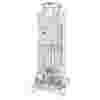Oxygen-enhanced combustion is a game-changing practice within glass furnaces. By elevating the oxygen concentration, the flame temperature soars, enabling a more thorough and rapid melting of raw materials. This results in a more uniform glass melt, which is essential for producing high-quality glass with minimal defects. The oxygen generator for glass industry use dramatically reduces the presence of imperfections like stones and cords, ensuring the structural and aesthetic quality of the glass.
Environmental Advantages of Oxygen Use in Glass Manufacturing
Choosing an oxygen generator for glass industry purposes aligns with contemporary environmental standards. Traditional air-fuel combustion in glass furnaces can release considerable amounts of NOx. Oxygen-enriched combustion significantly curtails these emissions, aiding in compliance with environmental regulations and enhancing air quality around production sites.
Boosting Furnace Efficiency and Production Capacity with Oxygen
The efficiency of glass furnaces is markedly increased through oxygen enrichment, which streamlines the combustion process and reduces fuel consumption. This not only lowers operational costs but also lessens the environmental impact. An oxygen generator for glass industry usage optimizes production capacity by improving efficiency, allowing manufacturers to produce more glass swiftly without sacrificing quality.
Enhancing Operational Flexibility in Glass Production with On-Site Oxygen Generators
Operational flexibility is yet another benefit provided by oxygen generators for the glass industry. The controlled use of oxygen permits better management of the furnace atmosphere, invaluable when altering glass types or colors. This ensures that manufacturers can quickly adapt to changing production needs without extensive downtime.







